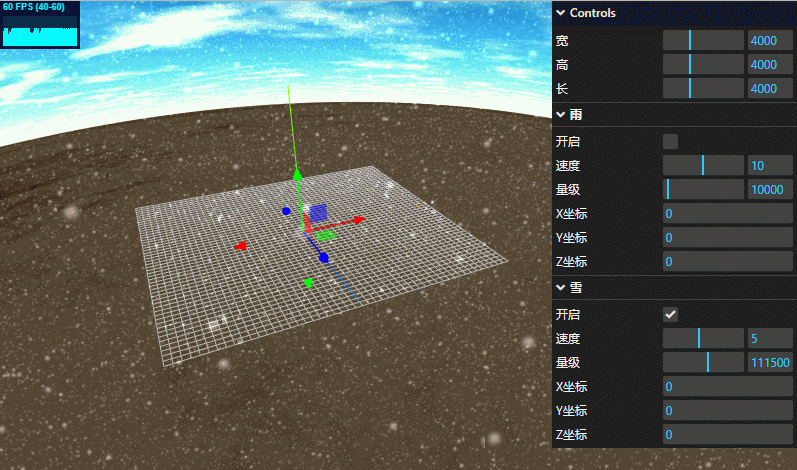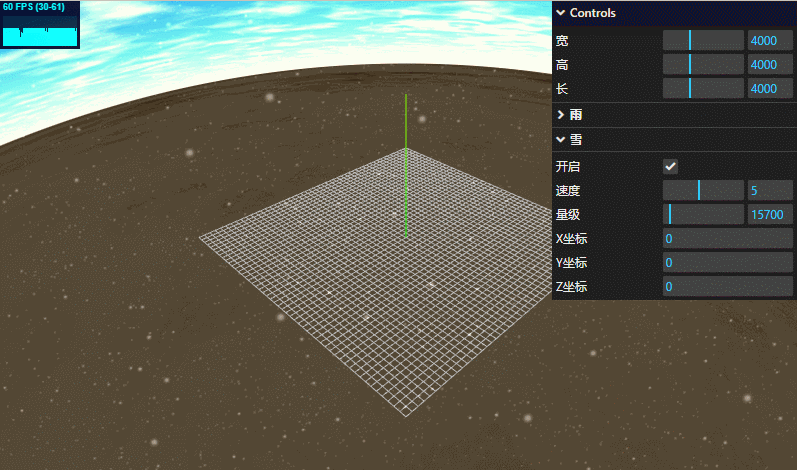目录
功能描述
在基于THREE.js的场景中,实现雨雪天气效果,可设置下雨、雪的范围、位置、量级以及下落速度。
最终效果
雪
雨

准备工作
材质贴图,包含雨点、雪花、环境球贴图,其中环境球贴图可有可无,如不用环境球,直接忽略即可。
实现原理
雨和雪的原理是一样的,仅仅是材质贴图和下落速度不一样。
在某一个确定的空间范围内,随机生成N个三维坐标点。这个范围可以是球体,也可以是六面体,本例使用的是六面体。另外,N越大,雨雪的密度就越大,通过调整N,可以修改雨雪等级。
/**
* 指定尺寸六面体内,随机生成三维向量
* @param width
* @param height
* @param depth
* @returns {THREE.Vector3}
*/
export function randomVectorInBox (width, height, depth) {
const x = random(-width / 2, width / 2)
const y = random(-height / 2, height / 2)
const z = random(-depth / 2, depth / 2)
return new THREE.Vector3(x, y, z)
}
// 向量坐标集合
const vectors = []
// 循环生成向量
for (let i = 0; i < N; i++) {
const v = randomVectorInBox(4000, 4000, 4000)
vectors.push(v.x, v.y, v.z)
} 创建一个BufferGeometry,将这N个坐标点以Float32BufferAttribute的形式,放入BufferGeometry的position属性中。
然后创建一个PointsMaterial材质,贴图就是雨或雪的贴图图片,这里的图片一定是png格式,否则你的雪花或者雨点会有棱有角非常难看。在设置下材质的透明度。
最后通过上述创建的几何体和材质对象,创建Points对象,添加到场景,这样我们就到了一个静止状态的雨雪效果。
const geometry = new THREE.BufferGeometry()
// 设置position
geometry.setAttribute('position', new THREE.Float32BufferAttribute(vectors, 3))
// 加载材质贴图
const texture = new THREE.TextureLoader().load(img)
// 创建材质
const materials = new THREE.PointsMaterial({
size: size,
map: texture,
blending: THREE.AdditiveBlending,
depthTest: true,
transparent: true,
opacity: 0.5
})
// 创建Points粒子对象
const particle = new THREE.Points(geometry, materials)但此时得到效果是静止的,我们需要让粒子下落来实现最终的效果,原理就是在requestAnimationFrame中,不断修改粒子的y轴坐标,实现下落,当然如果不想垂直下落,也可以同时修改其他坐标轴,来模拟风吹的效果,这里为了简单示意,就只修改y轴了。每次y轴的变化量V,决定了下落的速度。为了方便操作,我将上面生成的vectors集合,挂在了points对象上。下面是在requestAnimationFrame中每一帧刷新时执行的代码。
// 循环粒子坐标点
for (let i = 1; i < points.vectors.length; i += 3) {
// 修改y轴坐标,每次变化V,注意是减法,否则就上升了
points.vectors[i] = points.vectors[i] - V
// 此处判断是为了让粒子下落到最低点后,重复从最高点继续下落,实现循环下落
if (points.vectors[i] < -height / 2) {
const v = randomVectorInBox(width, height, depth)
particle.vectors[i] = height / 2
particle.vectors[i - 1] = v.x
particle.vectors[i + 1] = v.z
}
}
// 更新几何体position
points.geometry.setAttribute('position', new THREE.Float32BufferAttribute(points.vectors, 3))参数配置
修改V可以调整下落速度

修改六面体尺寸,可修改粒子范围

修改points的position,可以调整粒子整体在场景中的位置

修改N可以调整雨雪的量级

核心代码
demo是在vue上跑的,尽量把与本例无关的vue代码全部清除了。
// 创建场景封装对象(场景、光源等于本例无关的内容)
const ts = new TS('container')
// UI控制参数对象
this.controls = {
// 开启下雨
rainVisible: false,
// 雨滴四度
rainSpeed: 10,
// 雨量等级(密度)
rainGrade: 10000,
// 开启下雪
snowVisible: false,
// 雪花速度
snowSpeed: 5,
// 雪量等级(密度)
snowGrade: 10000,
// 覆盖范围-X
width: 4000,
// 覆盖范围-Y
height: 4000,
// 覆盖范围-Z
depth: 4000,
// 雨坐标
rx: 0,
ry: 0,
rz: 0,
// 雪坐标
sx: 0,
sy: 0,
sz: 0
}
// 雨雪对象
this.rain = null
this.snow = null
// GUI 方便调试
const gui = new GUI()
// 覆盖范围
gui.add(this.controls, 'width', 1000, 10000).step(10).name('宽').onChange(v => {
this.controls.width = v
// 刷新几何体
updateGeometry.call(this, 'rain')
updateGeometry.call(this, 'snow')
})
gui.add(this.controls, 'width', 1000, 10000).step(10).name('高').onChange(v => {
this.controls.height = v
// 刷新几何体
updateGeometry.call(this, 'rain')
updateGeometry.call(this, 'snow')
})
gui.add(this.controls, 'depth', 1000, 10000).step(10).name('长').onChange(v => {
this.controls.depth = v
// 刷新几何体
updateGeometry.call(this, 'rain')
updateGeometry.call(this, 'snow')
})
// 雨相关UI控制
const rainGroup = gui.addFolder('雨')
rainGroup.add(this.controls, 'rainVisible', false).name('开启').onChange(v => {
this.controls.rainVisible = v
// 创建粒子对象,否则删除并销毁
if (v) {
this.rain = generateParticle.call(this, 'img/rain.png', 'snow', 10)
ts.scene.add(this.rain)
} else {
this.rain.geometry.dispose()
this.rain.material.dispose()
this.rain.removeFromParent()
this.rain = null
}
})
rainGroup.add(this.controls, 'rainSpeed', 5, 15).step(1).name('速度').onChange(v => {
this.controls.rainSpeed = v
})
rainGroup.add(this.controls, 'rainGrade', 100, 200000).step(100).name('量级').onChange(v => {
this.controls.rainGrade = v
if (!this.rain) return
updateGeometry.call(this, 'rain')
})
rainGroup.add(this.controls, 'rx').step(1).name('X坐标').onChange(v => {
this.controls.rx = v
if (this.rain) this.rain.position.x = v
})
rainGroup.add(this.controls, 'ry').step(1).name('Y坐标').onChange(v => {
this.controls.ry = v
if (this.rain) this.rain.position.y = v
})
rainGroup.add(this.controls, 'rz').step(1).name('Z坐标').onChange(v => {
this.controls.rz = v
if (this.rain) this.rain.position.z = v
})
// 雪相关UI控制
const snowGroup = gui.addFolder('雪')
snowGroup.add(this.controls, 'snowVisible', false).name('开启').onChange(v => {
this.controls.snowVisible = v
if (v) {
this.snow = generateParticle.call(this, 'img/snow.png', 'snow')
ts.scene.add(this.snow)
} else {
this.snow.geometry.dispose()
this.snow.material.dispose()
this.snow.removeFromParent()
this.snow = null
}
})
snowGroup.add(this.controls, 'snowSpeed', 1, 10).step(1).name('速度').onChange(v => {
this.controls.snowSpeed = v
})
snowGroup.add(this.controls, 'snowGrade', 100, 200000).step(100).name('量级').onChange(v => {
this.controls.snowGrade = v
if (!this.snow) return
updateGeometry.call(this, 'snow')
})
snowGroup.add(this.controls, 'sx').step(1).name('X坐标').onChange(v => {
this.controls.sx = v
if (this.snow) this.snow.position.x = v
})
snowGroup.add(this.controls, 'sy').step(1).name('Y坐标').onChange(v => {
this.controls.sy = v
if (this.snow) this.snow.position.y = v
})
snowGroup.add(this.controls, 'sz').step(1).name('Z坐标').onChange(v => {
this.controls.sz = v
if (this.snow) this.snow.position.z = v
})
// 此处相当于requestAnimationFrame,只不过内部封装了一下
ts.updates.push(() => {
update.call(this, 'rain')
update.call(this, 'snow')
})
/**
* 更新几何体
* @param type
*/
function updateGeometry (type) {
// 获取粒子对象
const particle = this[type]
if (!particle) return
// 重新计算粒子坐标
const vectors = computeVectors.call(this, type)
// 更新属性
particle.vectors = vectors
particle.geometry.setAttribute('position', new THREE.Float32BufferAttribute(particle.vectors, 3))
}
/**
* 更新粒子移动
* @param particle
* @param speed
*/
function update (type) {
// 获取粒子对象
const particle = this[type]
if (!particle || !particle.vectors) return
// 获取速度
const speed = this.controls[type + 'Speed']
// 下落动画
for (let i = 1; i < particle.vectors.length; i += 3) {
particle.vectors[i] = particle.vectors[i] - speed
if (particle.vectors[i] < -this.controls.height / 2) {
const v = randomVectorInBox(this.controls.width, this.controls.height, this.controls.depth)
particle.vectors[i] = this.controls.height / 2
particle.vectors[i - 1] = v.x
particle.vectors[i + 1] = v.z
}
}
particle.geometry.setAttribute('position', new THREE.Float32BufferAttribute(particle.vectors, 3))
}
/**
* 计算粒子坐标
* @param type
* @returns {*[]}
*/
function computeVectors (type) {
const vectors = []
for (let i = 0; i < this.controls[type + 'Grade']; i++) {
// 从六面体范围内获取随机坐标
const v = randomVectorInBox(this.controls.width, this.controls.height, this.controls.depth)
vectors.push(v.x, v.y, v.z)
}
return vectors
}
/**
* 雨雪粒子
* @param img
* @param size
* @returns {any}
*/
function generateParticle (img, type, size = 15) {
const geometry = new THREE.BufferGeometry()
// 获取粒子坐标点集合
const vectors = computeVectors.call(this, type)
// 设置到几何体
geometry.setAttribute('position', new THREE.Float32BufferAttribute(vectors, 3))
// 加载贴图
const texture = new THREE.TextureLoader().load(img)
// 创建材质对象
const materials = new THREE.PointsMaterial({
size: size,
map: texture,
blending: THREE.AdditiveBlending,
// 是否永远置顶
depthTest: true,
transparent: true,
opacity: 0.5
})
const particle = new THREE.Points(geometry, materials)
particle.vectors = vectors
return particle
}
/**
* 指定尺寸六面体内,随机生成三维向量
* @param width
* @param height
* @param depth
* @returns {THREE.Vector3}
*/
export function randomVectorInBox (width, height, depth) {
const x = random(-width / 2, width / 2)
const y = random(-height / 2, height / 2)
const z = random(-depth / 2, depth / 2)
return new THREE.Vector3(x, y, z)
}






















 2806
2806











 被折叠的 条评论
为什么被折叠?
被折叠的 条评论
为什么被折叠?








